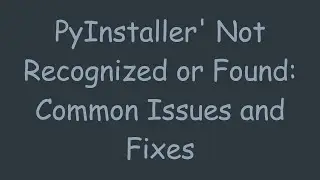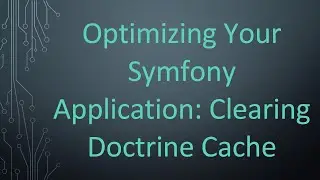Unlocking Python Function Attributes
на канале: vlogize
Discover how to easily retrieve and view attributes of Python functions in this comprehensive guide. Learn to use `vars()` to access function attributes effectively!
---
This video is based on the question https://stackoverflow.com/q/65448250/ asked by the user 'Igor Azikov' ( https://stackoverflow.com/u/14120993/ ) and on the answer https://stackoverflow.com/a/65448314/ provided by the user 'DeepSpace' ( https://stackoverflow.com/u/1453822/ ) at 'Stack Overflow' website. Thanks to these great users and Stackexchange community for their contributions.
Visit these links for original content and any more details, such as alternate solutions, latest updates/developments on topic, comments, revision history etc. For example, the original title of the Question was: How to see function attributes?
Also, Content (except music) licensed under CC BY-SA https://meta.stackexchange.com/help/l...
The original Question post is licensed under the 'CC BY-SA 4.0' ( https://creativecommons.org/licenses/... ) license, and the original Answer post is licensed under the 'CC BY-SA 4.0' ( https://creativecommons.org/licenses/... ) license.
If anything seems off to you, please feel free to write me at vlogize [AT] gmail [DOT] com.
---
Unlocking Python Function Attributes: A Simple Guide
Python is a versatile programming language that provides developers with a wide range of capabilities. One aspect that often goes unnoticed by many is the ability of functions to have their own attributes. This feature can be incredibly useful for organizing code and storing metadata related to functions. However, knowing how to access these attributes can be a bit of a challenge.
In this guide, we’ll explore how to view function attributes in Python, making this often-overlooked feature more accessible. We will break down the problem and provide a straightforward solution, complete with examples to help you understand.
Understanding the Problem
When we define a function in Python, we can attach attributes to that function just like we would with any other object. For example:
[[See Video to Reveal this Text or Code Snippet]]
In this snippet, we define a function func that squares its input and we give it an attribute called attr with a value of 1. The question arises: How do we access this attribute and see its value?
Searching for insights, one might try using the inspect.getfullargspec from the inspect module, which, although helpful for other functionalities, only returns information about the arguments of the function. So, while this approach can provide some useful information, it won't show the attributes we’re interested in.
The Solution: Using vars() to Access Function Attributes
Fortunately, Python provides a very convenient built-in function called vars() that we can leverage to see the attributes of a function. The vars() function returns the _dict_ attribute for a module, class, instance, or any object with a _dict_ attribute, and this includes our defined functions.
Step-by-step Example
Let’s take a closer look at how to use vars() to access function attributes:
Define your function and set an attribute:
[[See Video to Reveal this Text or Code Snippet]]
Use vars() to view attributes:
[[See Video to Reveal this Text or Code Snippet]]
Expected Output
When you run the above code, you will receive the following output:
[[See Video to Reveal this Text or Code Snippet]]
Conclusion
This simple method of using vars() allows you to easily access and view any attributes associated with your functions in Python, making it a powerful tool for those who wish to enhance their code with additional function metadata. Next time you want to check the attributes of a function, remember the ease of using vars() to get the job done smoothly.
By embracing these features within Python, you can increase the usability and organization of your code while taking full advantage of what Python's function attributes have to offer.
Ensure that you experiment with this technique in your own coding projects, and see how it can assist you in managing and optimizing your functions!































